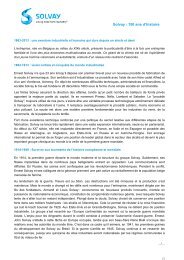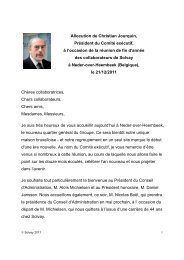Pharmaceuticals Sector - Solvay
Pharmaceuticals Sector - Solvay
Pharmaceuticals Sector - Solvay
You also want an ePaper? Increase the reach of your titles
YUMPU automatically turns print PDFs into web optimized ePapers that Google loves.
Expenditure on the future by <strong>Sector</strong><br />
(EUR million)<br />
27<br />
27<br />
261<br />
261<br />
79<br />
79<br />
293<br />
293<br />
14<br />
14<br />
13 17<br />
13 17<br />
351<br />
351<br />
1 346<br />
1 346<br />
R&D expenditure<br />
(EUR 472 million)<br />
SENSITIVITY TO ECONOMIC<br />
FACTORS<br />
An amendment to Belgian legislation (Companies<br />
Code) issued in January 2006 requires a description of<br />
the principal risks to be included in the management<br />
report. For 2005, this analysis can be found in the<br />
different sections of the present annual report:<br />
- provisions and Group policy with respect to insurance<br />
(see note 29 on provisions)<br />
- management of foreign exchange and interest rate<br />
risks (see note 31 on derivative financial instruments)<br />
- sensitivity to economic factors as presented below.<br />
The Group takes various measures to reduce its<br />
sensitivity to external economic factors such as foreign<br />
exchange fluctuations and energy prices.<br />
Foreign exchange fluctuations<br />
<strong>Pharmaceuticals</strong> = 351<br />
Chemicals = 27<br />
Plastics = 79<br />
Unallocated = 14<br />
Capital expenditure<br />
(EUR 1 930 million)<br />
<strong>Pharmaceuticals</strong> = 1 346<br />
Chemicals = 261<br />
Plastics = 293<br />
Unallocated = 13<br />
Discontinued operations = 17<br />
Foreign exchange fluctuations, particularly of the<br />
US dollar, can affect earnings. In 2005 the average<br />
EUR / USD exchange rate remained unchanged.<br />
Nonetheless, the exchange rate at the end of 2005<br />
was significantly different from that at the end of 2004.<br />
The geographic distribution of the Group’s activities<br />
throughout the world enables it to diversify its currency<br />
risk. In many of its activities the Group produces and<br />
sells on local markets.<br />
The Group’s policy of hedging the EUR / USD<br />
exchange risk is based essentially on the principles of<br />
financing its activities in local currency, systematically<br />
covering transactional exchange risk at the time<br />
of invoicing (risks which are certain) and hedging<br />
budgeted foreign currency cash flows on certain of its<br />
activities.<br />
The Group has also introduced an Average Rate<br />
Option, partially covering the conversion into EUR of a<br />
portion of earnings generated in the NAFTA zone.<br />
(see also note 31: “Derivative financial instruments” ).<br />
Energy situation<br />
The <strong>Solvay</strong> Group is relatively well protected against<br />
sharp price fluctuations in certain energy sources.<br />
<strong>Solvay</strong> has a four-pronged energy policy of:<br />
- long-term contracting (electricity in particular)<br />
- having diversified and flexible primary energy sources,<br />
- developing cogeneration plants,<br />
- more recently, a combined cycle generation plant<br />
at Rosignano (Italy), providing savings on electricity<br />
transportation costs.<br />
Over the past several years the Group has installed,<br />
alone or with third parties, a growing number of<br />
cogeneration units. In 2005 the group had around<br />
900 MW of installed cogeneration capacity in 13 of its<br />
plants, including 12 in Europe, covering a considerable<br />
portion of its needs for steam.<br />
2005 saw very sharp increases in fuel prices, in<br />
particular for gas. Here the Group’s specific energy<br />
policy enabled it to limit the rise in its energy bill to well<br />
below that of market prices. The net energy bill for<br />
2005 represents around 8% of sales.<br />
It should also be noted that the impact of fluctuating<br />
energy costs varies considerably from one activity to<br />
another, with the Chemicals <strong>Sector</strong> being the most<br />
sensitive. Depending on each SBU’s particular market<br />
conditions, price rises have been negotiated with our<br />
customers to offset these impacts.<br />
In 2006 energy prices remain very high.<br />
Raw materials<br />
Sensitivity to raw materials prices varies from one<br />
activity to another. As with energy, the Group<br />
negotiates supply contracts for its raw materials, in<br />
particular ethylene, and passes on price variations<br />
when market conditions permit.<br />
The Chemicals <strong>Sector</strong> is very highly integrated in<br />
terms of raw materials, with its own salt and limestone<br />
deposits (for soda ash, caustic soda and other products)<br />
and fluorspar mine (for fluorinated products), etc.<br />
<strong>Solvay</strong> Global Annual Report 2005<br />
55


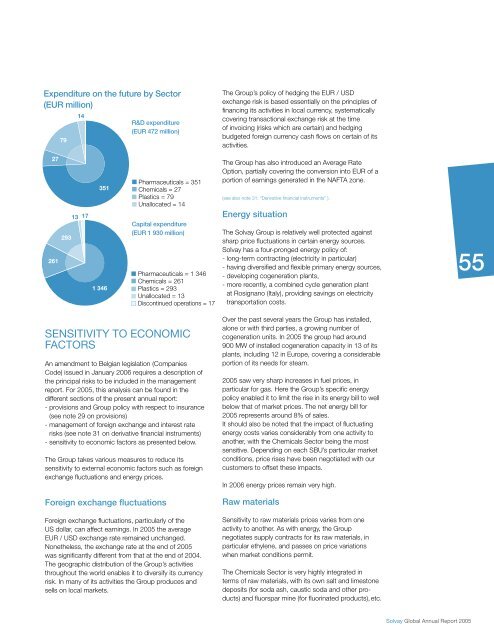

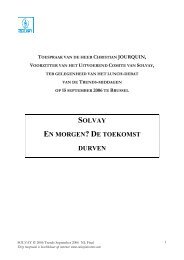
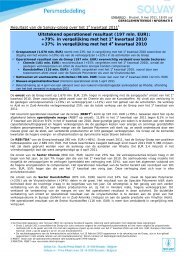

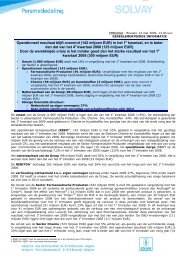
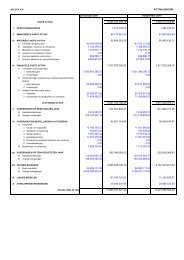


![PROC.1 [LETTRE] - Solvay](https://img.yumpu.com/16585746/1/184x260/proc1-lettre-solvay.jpg?quality=85)
